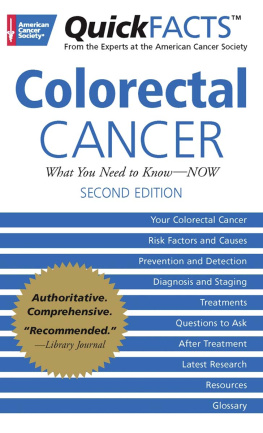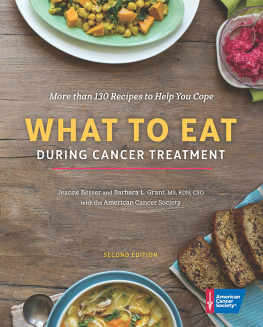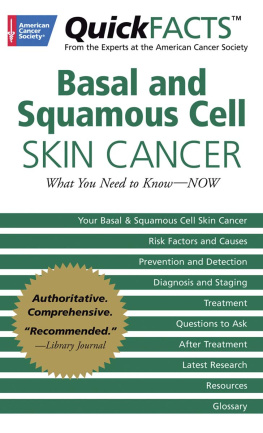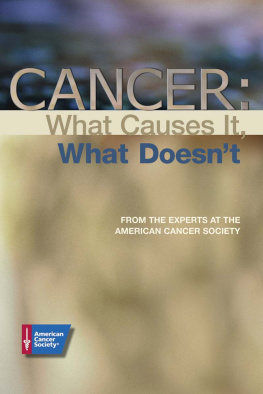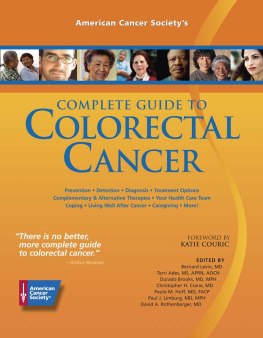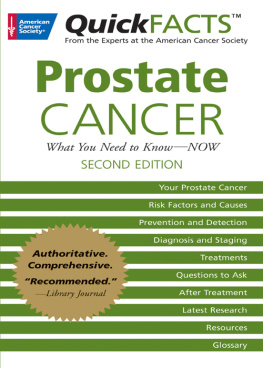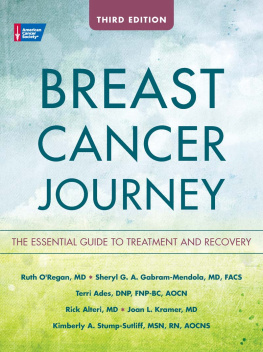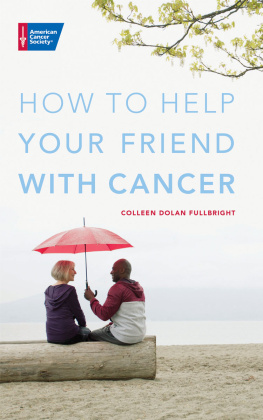

Published by the American Cancer Society/Health Promotions
250 Williams Street NW, Atlanta, Georgia 30303 USA
Copyright 2008 American Cancer Society
All rights reserved. Without limiting the rights under copyright reserved above, no part of this publication may be reproduced, stored in or introduced into a retrieval system, or transmitted in any form or by any means (electronic, mechanical, photocopying, recording, or otherwise) without the prior written permission of the publisher.
Printed in the United States of America
Cover designed by Jill Dible, Atlanta, GA
5 4 3 2 1 08 09 10 11 12
Library of Congress Cataloging-in-Publication Data
Quick facts colorectal cancer : what you need to knownow / from the experts at the American Cancer Society. 2nd ed.
p. cm. (Quick facts)
Rev. ed. of: Quick facts colon cancer. 2007.
Includes bibliographical references and index.
ISBN-13: 978-1-60443-007-3 (pbk. : alk. paper)
ISBN-10: 1-60443-007-9 (pbk. : alk. paper)
1. Colon (Anatomy)CancerPopular works.
2. RectumCancerPopular works. I. American Cancer Society. II. Quick facts colon cancer. III. Title: Colorectal cancer.
RC280.C6Q53 2008
616.994347dc22
2008019967
A Note to the Reader
This information represents the views of the doctors and nurses serving on the American Cancer Societys Cancer Information Database Editorial Board. These views are based on their interpretation of studies published in medical journals, as well as their own professional experience.
The treatment information in this book is not official policy of the Society and is not intended as medical advice to replace the expertise and judgment of your cancer care team. It is intended to help you and your family make informed decisions, together with your doctor.
Your doctor may have reasons for suggesting a treatment plan different from these general treatment options. Dont hesitate to ask your doctor about your treatment options.
For more information, contact your American Cancer Society at 800-ACS-2345 or http://www.cancer.org.
Bulk purchases of this book are available at a discount. For information, contact the American Cancer Society at .
TABLE OF CONTENTS
Your Colorectal Cancer
What Is Cancer?
Cancer develops when cells in a part of the body begin to grow out of control. Although there are many kinds of cancer, they all start because of out-of-control growth of abnormal cells.
Normal body cells grow, divide, and die in an orderly fashion. During the early years of a persons life, normal cells divide rapidly. After the person becomes an adult, cells in most parts of the body divide only to replace worn-out or dying cells and to repair injuries.
Because cancer cells continue to grow and divide, they are different from normal cells. Instead of dying in the expected time frame, cancer cells outlive normal cells and continue to form new abnormal cells.
Cancer cells develop because of damage to DNA. DNA is in every cell and directs all the cells activities. Most of the time when DNA becomes damaged, the body is able to repair it. In cancer cells, the damaged DNA is not repaired. People can inherit damaged DNA, which accounts for inherited cancer. Many times though, a persons DNA becomes damaged by exposure to something in the environment, like smoke.
Cancer usually forms as a tumor. Some types of cancer, like leukemia, do not form tumors. Instead, these cancer cells involve the blood and blood-forming organs and circulate through other tissues where they grow.
Often, cancer cells travel to other parts of the body, where they begin to grow and replace normal tissue. This process is called metastasis. Regardless of where a cancer may spread, however, it is always named for the place it began. For instance, breast cancer that spreads to the liver is still called breast cancer, not liver cancer.
Not all tumors are cancerous. Benign (noncancerous) tumors do not spread (metastasize) to other parts of the body and, with very rare exceptions, are not life-threatening.
Different types of cancer can behave very differently. For example, lung cancer and breast cancer are very different diseases. They grow at different rates and respond to different treatments. That is why people with cancer need treatment that is aimed at their particular kind of cancer.
Cancer is the second leading cause of death in the United States. Cancer will develop in nearly half of all men and a little over one-third of all women in the United States during their lifetimes. Today, millions of people are living with cancer or have had cancer. The risk for developing most types of cancer can be reduced by changes in a persons lifestyle; for example, by quitting smoking and eating a better diet. The sooner a cancer is found and treatment begun, the better the chances are for living many years.
What Is Colorectal Cancer?
Colorectal cancer refers to cancer that develops in the colon or the rectum. Colorectal cancer is sometimes referred to separately as colon cancer or rectal cancer, depending on where it starts. Colon cancer and rectal cancer have many features in common. They are discussed together in this book except for the chapter on treatment, in which they are discussed separately.
The Normal Digestive System
The colon and rectum are parts of the digestive system, which is also called the gastrointestinal (GI) tract (see picture on page ). In order to understand colorectal cancer, it helps to have some basic knowledge about the normal structure and function of the digestive system.
After food is chewed and swallowed, it travels through the esophagus to the stomach. There it is partly broken down and then sent to the small intestine (also known as the small bowel). The word small refers to the diameter of the small intestine, which is narrower than that of the large bowel (colon and rectum). Actually, the small intestine is the longest segment of the digestive systemabout 20 feet. The small intestine continues breaking down the food and absorbs most of the nutrients.
The small intestine joins the colon in the right lower abdomen. The colon (also called the large bowel or large intestine) is a muscular tube about 5 feet long. The colon absorbs water and salt from food matter and serves as a storage place for waste matter.
The colon has 4 sections:
- The first section is called the ascending colon. It starts with a small pouch (the cecum) where the small bowel attaches to the colon and extends upward on the right side of the abdomen. The cecum is also where the appendix attaches to the colon.
- The second section is called the transverse colon; it goes across the body from the right to the left side in the upper abdomen.
- The third section, the
Next page
